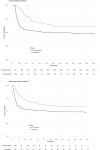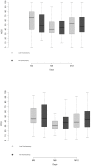Tracheostomy and long-term mortality in ICU patients undergoing prolonged mechanical ventilation
- PMID: 31577804
- PMCID: PMC6774500
- DOI: 10.1371/journal.pone.0220399
Tracheostomy and long-term mortality in ICU patients undergoing prolonged mechanical ventilation
Abstract
Introduction: In critically ill patients undergoing prolonged mechanical ventilation (MV), the difference in long-term outcomes between patients with or without tracheostomy remains unexplored.
Methods: Ancillary study of a prospective international multicentre observational cohort in 21 centres in France and Belgium, including 2087 patients, with a one-year follow-up after admission. We included patients with a MV duration ≥10 days, with or without tracheostomy. We explored the one-year mortality with a classical Cox regression model (adjustment on age, SAPS II, baseline diagnosis and withdrawal of life-sustaining therapies) and a Cox regression model using tracheostomy as a time-dependant variable.
Results: 29.5% patients underwent prolonged MV, out of which 25.6% received tracheostomy and 74.4% did not. At one-year, 45.2% patients had died in the tracheostomy group and 51.5% patients had died in the group without tracheostomy (p = 0.001). In the Cox-adjusted regression model, tracheostomy was not associated with improved one-year outcome (HR CI95 0.7 [0.5-1.001], p = 0.051), as well as in the model using tracheostomy as a time-dependent variable (OR CI 95 1 [0.7-1.4], p = 0.9).
Conclusions: In our study, there was no statistically significant difference in the one-year mortality of patients undergoing prolonged MV when receiving tracheostomy or not.
Trial registration: NCT01367093.
Conflict of interest statement
Samir Jaber is consultant for Drager, Fisher-Paykel, Xenios and Medtronic. The other authors have no financial disclosures and no conflict of interest to declare about this work. This does not alter our adherence to PLOS ONE policies on sharing data and materials.
Figures



References
Publication types
MeSH terms
Associated data
LinkOut - more resources
Full Text Sources
Other Literature Sources
Medical

